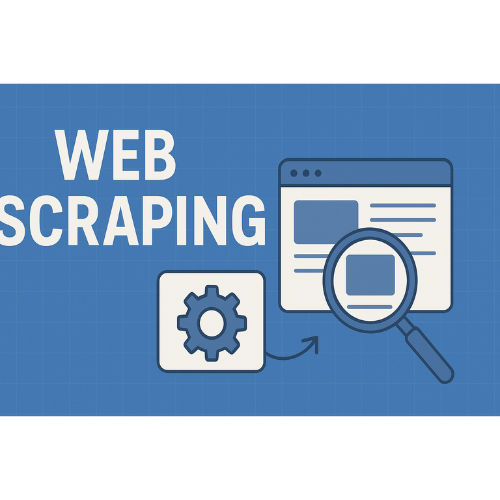
10 Common Mistakes to Avoid with Automated Web Scraping
- pradip wagh
- Technology
- 2025-11-06 17:08:10
- 2166K
At KanhaSoft we’ve seen it all — the good, the bad, and the (oh-so) ugly when it comes to automated web scraping. If you’re planning to deploy web scraping services or leverage web scraping tools, you’ll want to sidestep these classic missteps (because yes — we’ve tripped over most of them ourselves). So let’s dive in — with a little self-deprecating humour and a healthy dose of practical insight.
Automated web scraping: what’s the big deal?
We like to start here, because too often folks jump into web scraping without thinking about why. Automated web scraping isn’t just clicking “run”. It’s a technical dance of proxies, headers, dynamic pages, anti-bot protections, data cleanliness, and legal compliance. Think of it like baking a soufflé – skip one step and you end up with a pancake. We know: we learned this the hard way when, in our early days, we attempted to scrape a price-comparison site, forgot to respect robot exclusions, got blocked, and ended up playing whack-a-proxy for two days. (Yes, two days.)
If you’re considering Ai web scraping tools, remember: the difference between success and failure often comes down to avoiding the common mistakes we’ll outline below.
Mistake One: Treating scraping as a “set and forget” job
One of the most frequent errors we spot: believing that once you build your scraper, you’re done. Nope. Websites evolve. HTML structures change, elements move, JavaScript frameworks shift, and suddenly your scraper is extracting empty strings or broken data.
At KanhaSoft we tell our clients: “Scrape today, maintain tomorrow.” It’s an ongoing commitment. If you engage web scraping services, ask: who monitors changes? If you rely solely on web scraping tools, ask: how will you handle site redesigns? Without this mindset, you’ll end up in triage mode while your competitors carry on.
Mistake Two: Ignoring legal & ethical considerations
Yes, we said it — the legal stuff. But it matters. Scraping without regard for a site’s terms of service, or ignoring robot-exclusion files (robots.txt), can land you in murky waters. We’ve seen projects grind to a halt because someone forgot to check a site’s policy or failed to authenticate properly.
When choosing web scraping services, ensure they operate with compliance in mind. When using web scraping tools, ensure you’re not violating usage terms or intellectual-property rights. After all — better safe than sorry (and fewer nasty letters from legal teams).
Mistake Three: Underestimating anti-bot measures
Here’s a little anecdote: we once built a fancy scraper for a client’s competitor-monitoring feed. We launched it and thought we’d nailed it — until the site started returning CAPTCHAs, IP bans, or disguised JavaScript that loaded data after the page. Oops. We should have prepared.
Anti-bot defenses are everywhere now. If you treat a website like it’s still 2005, you’re in trouble. Modern web scraping tools and services must handle headless browsers, rotating proxies, user-agent spoofing, JavaScript rendering, and more. If you aren’t investing in those capabilities, expect mediocre data or failed runs.
Mistake Four: Using fragile selectors / brittle logic
The rule at KanhaSoft: “Don’t depend on the class name ‘price-tag-green’ staying around forever.” Selectors that are too specific or rely on unstable attributes will break at the slightest redesign.
If your scraper relies on brittle logic, you’ll spend most of your time debugging instead of extracting value. Instead, build resilient logic: use semantic structure, fallback paths, and error-handling. If you hire web scraping services, ask about their robustness. If you pick web scraping tools, look for features like selector fallback, heuristic extraction, or machine-learning-based tagging.
Mistake Five: Overlooking performance & scalability
We once architected a scraper for a fast-growing e-commerce site, then realised our design couldn’t scale beyond 100 pages per hour because we hadn’t thought about rate-limiting, concurrency control, or efficient scraping pipelines. Our client got… anxious.
When you plan for web scraping services or run web scraping tools yourself, consider: how many pages per second? How many parallel threads? How do you queue tasks and retry failures? How do you store and process results efficiently? Without performance planning, you’ll bottleneck while your data backlog stacks up.
Mistake Six: Neglecting data cleaning and validation
Extracting data is half the job — cleaning and validating it is the other half. Too often we see raw output like “N/A”, “–”, “unknown”, or mis-parsed values, then business users complaining “Hey, this looks wrong”.
At KanhaSoft we emphasise: “Your data isn’t just raw — it must be reliable.” Whether using web scraping services or tools, build in extraction validation, type checking (dates, numbers), missing-value handling, and logging of anomalies. That way you can trust your feed instead of scratching your head.
Mistake Seven: Forgetting change-management hooks
Once we inherited a legacy scraping tool that broke every time the target site changed. But worse: nobody logged those breakages. The team only found out when the downstream dashboard showed blank values. Not fun.
When you're using web scraping services or tools, implement these: monitoring & alerting (when extraction drops significantly), versioning of scraping code, audit logs of runs, and recovery mechanisms. That way you catch issues early — not after the CEO asks, “Why is our feed silent?”
Mistake Eight: Failing to consider storage, processing & pipeline design
Scraping is more than grabbing HTML. You need to store results, process them, maybe normalise them, feed to analytics or dashboards. We’ve seen clients build brilliant scrapers, then forget how to pipeline results, so the data sat in CSV files, unmanaged.
If you only think “let’s scrape”, you’ll end up with data chaos. At KanhaSoft we integrate scraper output into ETL pipelines, data warehouses, cleaning layers, and downstream dashboards. If you pick web scraping services, ask: how do you deliver data? If you pick web scraping tools, ask: how will you store & process results? This stuff matters.
Mistake Nine: Not designing with fault tolerance or retries
Scraper tasks fail. Sites timeout. IPs block. JavaScript hangs. If you treat it like a one-shot operation, you’ll bug out when something fails. (Yes, we’ve been there — midnight emergency debugging, coffee-fueled.)
Instead, build fault-tolerant pipelines: retry logic, fallback proxies, fallback parsing logic, logging of failures, cooldown mechanisms. A robust web scraping setup doesn’t panic when one page fails — it logs, retries, moves on. If you rely on web scraping tools or services, check their fault-tolerance features.
Mistake Ten: Ignoring maintainability and documentation
Finally — this might be the most silent killer. We once inherited a scraping project that no one documented. Variables named “a”, “b”, “c”, and logic chained across multiple scripts. We spent days deciphering what “a > b ? c : d” did. (In hindsight: we could have been playing golf.)
If you build or buy web scraping services or tools, insist on documentation and maintainable code. At KanhaSoft we treat our scraping modules like any other production service: version control, comments, README files, architecture diagrams. When your colleague leaves for sunnier pastures, the scraper should still behave without hand-holding.
Bringing it all together
Now, if you made it this far — well done. We’ve walked through ten common mistakes that plague web scraping initiatives. From “we’ll just build it once” (and forget it) to “oops, data’s wrong” to “why doesn’t this pipeline scale?” — we’ve been through it. And—not to brag—but we’ve survived to tell the tale (and fix the fire-drills). At KanhaSoft we believe automation isn’t a magic wand; it’s a discipline. Effective web scraping services and web scraping tools are built, maintained, and evolved.
Quick summary in a table
| Mistake | Key takeaway |
|---|---|
| Set and forget | You must plan for ongoing maintenance. |
| Ignoring legal | Be compliant. Know terms of service. |
| Underestimating anti-bot | Use proxies, headless browsers, rotation. |
| Fragile logic | Use robust selectors and fallback paths. |
| Poor scalability | Design for concurrency, queuing, pipeline. |
| Neglect data cleaning | Clean and validate your output. |
| No change-management | Monitor, alert, version control. |
| Poor storage/process design | Integrate scraping into your data stack. |
| No fault tolerance | Retry, fallback, log errors. |
| No documentation | Maintain code for the long term. |
Final thought
In closing (as the wise folks at KanhaSoft would say), automation is powerful — but only if you treat it with respect. When you deploy scraper logic, monitor it, document it, and maintain it — you turn a brittle hack into a reliable asset. Avoiding the ten mistakes above will not guarantee perfection, but it will save you from midday heart-stops and frantic calls to the dev team. So pick your tools, choose your services wisely, plan for change, and don’t forget: even a great scraper needs a little love. After all — if you build it (and maintain it), they will scrape.
FAQs
What are the best web scraping services for large-scale projects?
We (at KanhaSoft) evaluate services with the following criteria: scalability (thousands of pages/hour), compliance (legal & ethical), robustness (anti-bot handling), data delivery format (JSON, CSV, database), maintainability. Choose a provider who offers monitoring, logging, and support — not just a one-off build.
Which web scraping tools do you recommend for developers?
Again, from our experience: favour tools that support headless browser automation (e.g., Puppeteer, Selenium), rotating proxy integration, robust parsing (XPath, CSS selectors, plus heuristics), error-handling and scheduling. Avoid tools that force you into brittle logic or manual monitoring.
What should I check before selecting a web scraping services vendor?
Make sure they handle changes (site redesigns), manage proxies/IP rotation, deliver data cleanly, log errors, monitor performance, and respect legal boundaries. Ask for references and look at how they respond to site updates.
How do I estimate the cost of a scraping project?
Cost depends on complexity (number of pages, dynamic content, anti-bot defences), frequency (one-time vs ongoing), volume of data, storage/processing needs, localisation (geographically diverse proxies). Build a clear scope and ask for phased pricing: build + maintenance.
Can using web scraping tools in-house be cheaper than web scraping services?
Potentially yes — but you gain responsibility. You’ll need to monitor changes, manage proxies, handle storage pipelines, cleaning logic, and integration. If you’re short on internal resources, a service may be more cost-effective in the long run.
What’s the long-term maintenance consideration for web scraping?
Expect site changes. Plan for updates every few months. Build maintainable code. Version-control everything. Monitor extraction health. Set aside resourcing for “fix the scraper” cycles. Treat scraper code like production software — not a weekend hack.
Leave a Reply
Please login to post a comment.












0 Comments